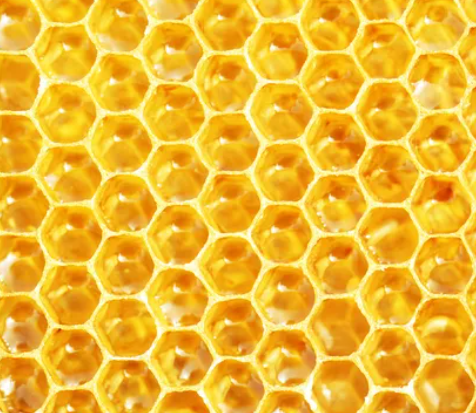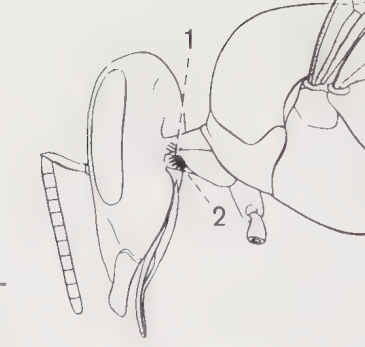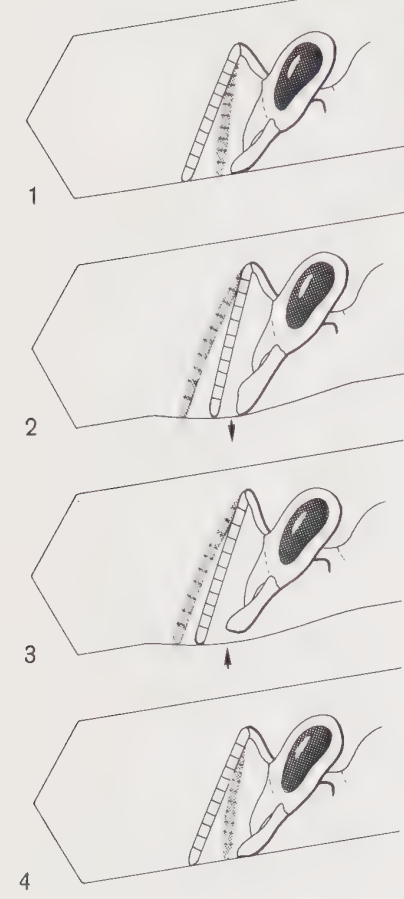This article will focus on the miraculous construction of the honeycomb in which all processes of the bee’s life take place, from birth until death, and it’s also where all their honey (and bee pollen) is stored. When one looks at the honeycomb one can’t but wonder how such perfectly shaped hexagon cells (the singular boxes of the honeycomb) could have been formed. It’s a work of perfection made pretty much in the pitch dark! (The hive only has a small opening, typically on the bottom of it, so there’s no “window” from which sunlight can come in it.) The honeycomb is something that has been extensively studied and what these studies show is mind-bogglingly complexity. It truly shows the amazing abilities that Hashem put into the tiny bee’s brain!
Here are words taken from scientific writeups. “The honeycomb structure is a testament (witness) to the mathematical genius of honeybees. Its efficiency, strength, and adaptability have inspired countless innovations (which means improvements) in engineering and design. Next time you see a honeycomb, take a moment to appreciate the intricate mathematical principles behind this remarkable natural wonder. Here’s another quote from a different science article entitled The Mathematical Genius of Honeycomb Design. Have you ever wondered why honeycombs are built with hexagonal cells? It’s not just a matter of chance; it’s a testament to the mathematical brilliance of honeybees. The hexagonal shape, with its six equal sides and angles, is the most efficient and strongest way to build a structure, especially when it comes to maximizing space and minimizing materials. Here’s another quote from a very well-known scientist. He described the bees’ ability to build perfect honeycombs as “the most wonderful of all known instincts.” Each hexagonal cell is so precisely constructed and so neatly arrayed that a [honey]comb is a visual treat. See picture 1.
Picture 1

So, we have scientists calling honeybees “mathematical geniuses” and having “mathematical brilliance”. Well, I don’t think the bees have any way of becoming geniuses or brilliant, however, their CREATOR HASHEM certainly is capable of putting into their tiny brains, these amazing mathematical processes with which to make the perfect honeycomb (while in the dark)! Now, in order to make sure that we will notice Hashem’s amazing talents that He gave to the honeybee, He made its construction to be done in a more complicated way then would have seemed necessary. Hashem made it that no single cell is made completely by one bee. Each cell is started by one bee and finished off by another bee. In fact, many bees are employed in the building of each individual cell and they often relieve each other at intervals of no more than half a minute or so. Apparently, each bee immediately comprehends what stage the construction has reached at the place where she starts to work and continues accordingly. Nevertheless, the job is finished off with the perfection as if one bee did it all by itself. Not only that, but the honeycomb as a whole is usually started off from three different places, with all three parts eventually joining together – seamlessly. Researchers write that the bees have the ability to manipulate the comb cells’ size and orientation so craftily that their ability can be considered “a true architectural skill,”. So, here you have it. Bees have “true architectural skill” and according to the blind scientists, it’s all by accident!
Now, we will embark on explaining what the amazement is all about.
Firstly, Why Hexagons? Why did Hashem program the bees’ brain to shape their wax into hexagons? So, it’s important to know that it takes bees eating 8 oz of honey for the bees to produce one ounce of wax. So, the better they make usage of the wax, the less honey they need to consume.
Maximum Space, Minimum Material: Imagine a flat surface covered with identical shapes. Triangles, squares, and hexagons can all fit together without any gaps. But, hexagons use the least amount of actual material to cover the most amount of space. This is crucial for honeybees, who need to build a strong and efficient home with limited resources so the hexagon utilizes the least amount of material for the same space then if it was squares or triangles. Strength and Stability: Hexagons distribute weight evenly across their structure, making them incredibly strong. Think of a honeycomb – it can withstand significant pressure without collapsing. This is why honeycombs are often used as inspiration in engineering, from aircraft parts to building materials.
The Math Behind Honeycombs Let’s delve into the math behind this fascinating structure: Angles: Each angle in a hexagon measures 120 degrees. This consistent angle allows the cells to fit together perfectly, creating a strong, even and stable structure. The next two calculations I have absolutely no idea what they mean, but it’s the mathematical reasons as to why the hexagon is THE BEST shape to use. These calculations could NEVER come about by accident. It’s only Hashem who could come up with these amazingly efficient calculations. Area: The area of a hexagon is calculated using the formula: Area = (3√3/2) * side². This formula highlights the efficient use of space in a hexagonal structure. Perimeter: The perimeter of a hexagon is calculated using the formula: Perimeter = 6 * side. This formula shows that hexagons have a shorter perimeter compared to other shapes with the same area, making them more efficient in terms of material usage. So, these calculations explain (not that I understand them) why the hexagon IS the best shape to use, providing the maximum strength with the least amount of material. So, even though the hexagon is surely the more difficult of the three optional shapes to form, (between triangles, squares, and hexagons), Hashem made the bees use that shape because of the extra strength it provides, and the minimum amount of material needed to make it.
So, now, we must delve into the amazing, almost impossible task of the bee being able to shape each wall at an exact 120-degree angle to the wall next to it, and each wall with its exact length, AND EACH WALL WITH ITS EXACT THICKNESS! The bees need the ability to manufacture extraordinarily thin walls. In addition to that, the cell walls are built in a way that they have a gradient (slant) of about 13 degrees from their base to their opening. This is enough of a slant to prevent the thick honey from running out. Now, since there’s a vertical wall so the cells can be built on both sides of the comb! Then Hashem made the bees make the back-to-back cells in a very particular way. The make the cells with all the cells on one side of the wall being a little offset from the cells on the other side of the wall. This makes it that the center of the bottom of one cell on one side of the wall, has as its base from the cells right behind it on the other side of the wall, THREE partial walls of the bottom of three partial cells that are right behind it. This works the same way on the other side as well. (They are NOT FORMED with one cell exactly behind the opposite cell on the other side of the wall, as one would have thought the bees would have done on their own, without Hashem putting instructions in their mind to set it up differently.) This gives it MUCH MORE STRENGTH! How’s that for economical usage!? See picture 2.
Picture 2

The distances from one cell wall to the other is 5.2 millimeters. The thickness (or should I say thinness) of each cell wall is just 0.073 of one millimeter, (with a tolerance of error of no more than 0.002 millimeter, which is really, really a tiny, tiny margin of error)! To understand these numbers a little better, we must know that one inch is a little over 25 millimeters, and .073 of one millimeter is about .003 of one inch. For a better perspective, an average sheet of copy paper is 0.1 of one millimeter, and the cell wall is .073 of one millimeter. Another way to grasp the thinness of .003 of an inch is to know that it is about the width of a human hair! What truly astounding precision! Economy in the use of building material is thus taken to the utmost limit. Human craftsmen could never do work of this nature without the use of special carpenter tools.
So, the question is, how can the bee shape the cells with such accuracy, without any tools? The answer is that Hashem put in to them built in “tools” that enable the job to get done. Firstly, the have special, very sensitive thick bristle hairs by their neck area. (See picture 3 by the neck area.) These bristles have tremendous sensitivity, and somehow it enables them to be able to detect the exact line of gravity. Meaning, it can tell what is an exactly flat line and it can tell by how many degrees something is not flat. So, who needs a ruler when you can have such special built in machinery!
Picture 3

This point has been proven experimentally. These bristle hairs were put out of action by coating the bristles with a warm mixture of wax and rosin which hardened on cooling and by which they were completely immobilized. They took bees that were in a building stage of their life cycle and they all immediately gathered together, but nothing happened. They behaved like workmen whose tools have been confiscated: they did not work. Mind you, the gumming up of their neck bristles had clearly not impaired their general well-being, because the flying-out and food gathering activities of the hive were still normal. Nor was there a reduction in their production of wax, but the flakes just dropped to the ground, unused. In one such experiment which observed the bees over a whole months time, no more than three pitiful little cells with irregular walls were produced during the first two weeks. Then came a heat wave. The coating substance started to melt, and the tips of the sensory hairs reappeared. The result was that the bees, within the next four days, after producing some irregular transitional shapes, managed once more to build more or less normal shaped cells.
Now we need to figure out how the bees are able figure out the thickness of the cell walls. How could they keep to the exact thickness of 0.073 millimeters on a consistent basis? As was written in a scientific article, “one might think that the workers had received a thorough training in physical mechanics”! However, because of its complexity, only the basic principle involved will be briefly explained here.
Picture 4

The bee presses her mandibles (mouth part) against the cell wall with a very specific amount of pressure. (see figure 1) and thereby it produces a very specific amount of indentation. (See figure 2) When she withdraws her mandibles (figure 3), the wall bounces back to its original shape (figure 4). During this process, she is also examining that section of the wall with the tips of her antennae. These tips are endowed with special sensory organs. The antennae are placed onto the wall. Their antennae then registers the speed of the bouncing back movement of the wall. How quickly it will bounce back depends entirely on the thickness of the wall and that “bounce back” registers on the tips of the antennae, thereby giving it a very accurate reading of the thickness of the wall!!!
Let’s now analyze this amazing feat. Firstly, they must have a built-in knowledge of EXACTLY how much to push the wall out, and a built-in knowledge of how quickly the wall must bounce back, in order to be able to calculate if it’s the correct thickness or not! (Where in the world did they learn this from?) If, it’s the incorrect thickness, it will either be faster or slower than the correct speed! If the wall is too thick, they will shave some wax off and then measure the bounce again. If it’s too thin, it will add wax, and then measure it again. (It’s interesting to note that when the tips of the antennae were experimentally removed, this abruptly put an end to the bee’s precision work. The bee still managed the basic architecture of the cells, but the walls got either too thin, or, more often, too thick.)
So, the next question is – with what super precise, micro (or nano) electric superconductor chip can they measure the speed of the movement??? Do they have some internal speedometer in them? Do they have a radar machine that can clock the speed? How it can figure out the actual speed that it is bouncing back is absolutely amazing!! How is all this possible?! Is it an accident? It’s completely insane to think that these sensitive structures that work so precisely, found in their neck and in their antennae, can be accidents. How in the world can it know all the exact measurements that are needed, and then, how in the world can they actually go about to measure them?! Hashem has made this most wonderous little bee with amazing abilities. We humans, that need all types of tools to measure these types of things are amazed, and baffled at what the little bee can accomplish without tools! ONLY our great CREATOR, Hashem, could give all these abilities to our little bee. Bees are one of the many, many live machines that Hashem has put into His world to accomplish various purposes (like making honey and pollinating trees and plants). How wonderous are Your works Hashem!!! They are all made with amazing wisdom!
BE”H in the next article we will discuss how honeybees communicate with each other. We will also bl”n discuss a certain type of bee that knows how to make paper!
About the Author
Rabbi Shmuel Waldman is a highly respected educator and Torah scholar, with over 50 years dedicated to the study and teaching of Judaism. His formative years were spent at the esteemed Mirrer Yeshiva, where he developed a strong foundation in Torah learning. Influenced by the profound teachings of Rabbi Avigdor Miller ZTL and guided by his close association with Rav Don Segal, shlit”a, Rabbi Waldman has become a leading voice in Jewish education and thought.
As Mashgiach of Yeshiva Mercaz Hatorah of Belle Harbor, Rabbi Waldman provided spiritual guidance and mentorship to generations of students. His book, Beyond a Reasonable Doubt: Convincing Evidence to the Truths of Judaism, published in 2002, remains a cornerstone in the world of kiruv. This widely acclaimed work has sold tens of thousands of copies, offering readers a clear and compelling understanding of Judaism’s core beliefs.
Rabbi Waldman has also shared his knowledge as a teacher at Yeshiva Tiferes Moshe and inspired countless students through his involvement in Jewish summer camps. Currently, he is focused on writing an in-depth Sefer on the transformative power of prayer, emphasizing its importance in daily life. He has also expanded his educational efforts through a blog and YouTube channel, where he addresses topics like Intelligent Design and critiques the Theory of Evolution.
Rabbi Shmuel Waldman’s lifelong dedication to teaching and inspiring others has left an indelible mark on the Jewish community, enriching the lives of students and readers worldwide. His work continues to guide individuals on their spiritual journeys and deepen their connection to Judaism.